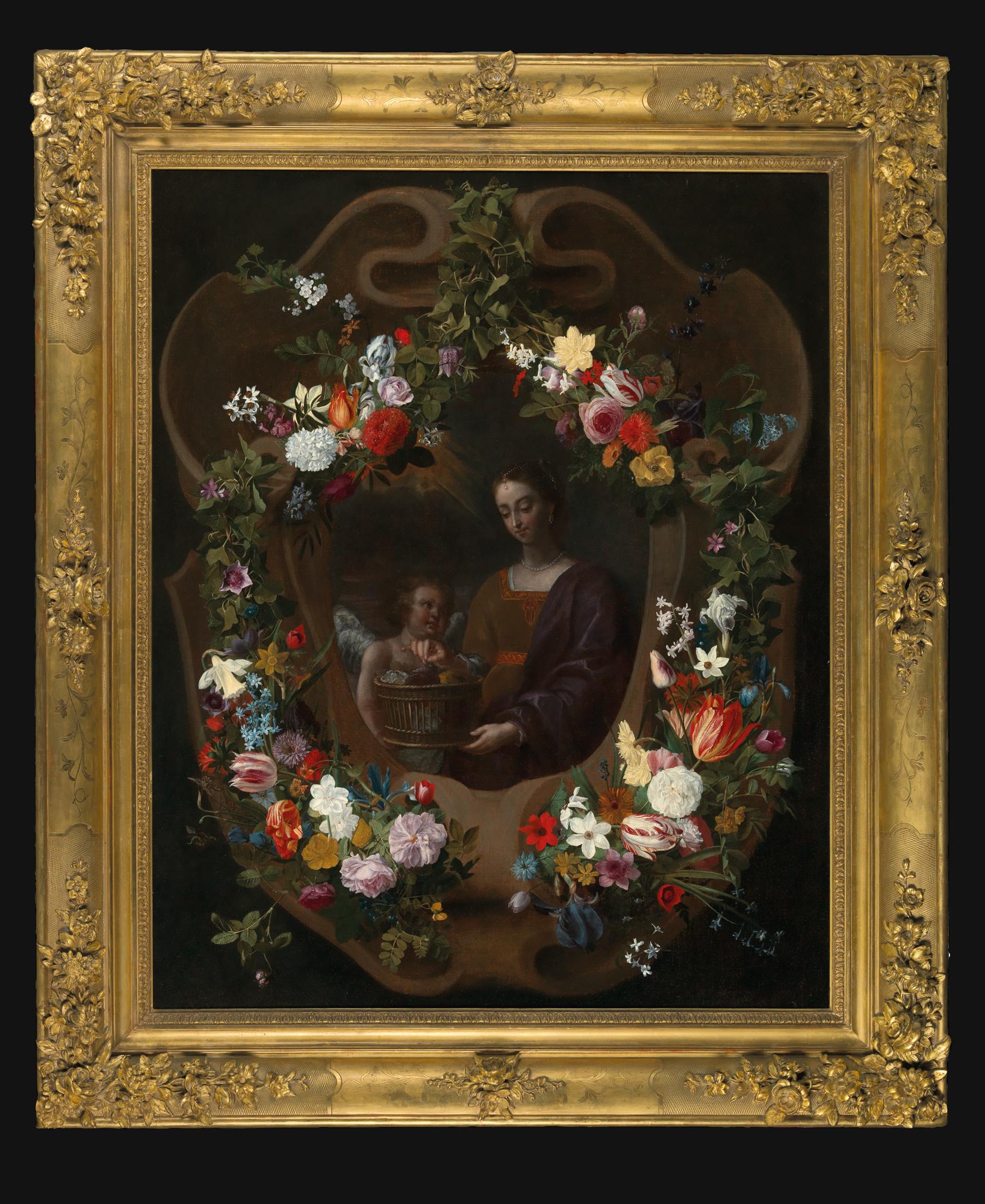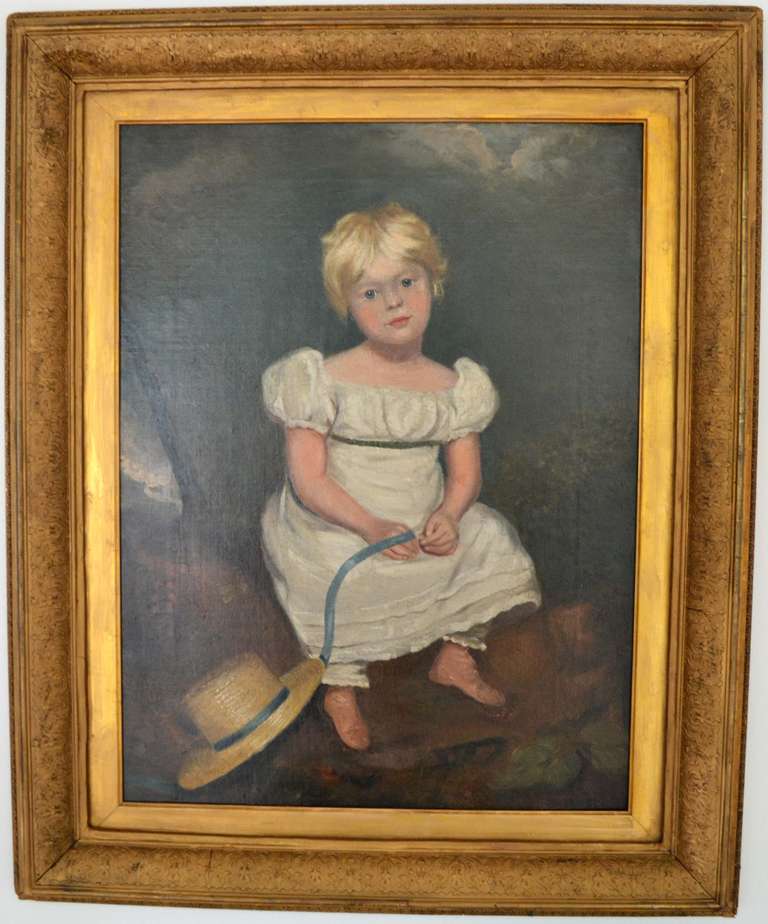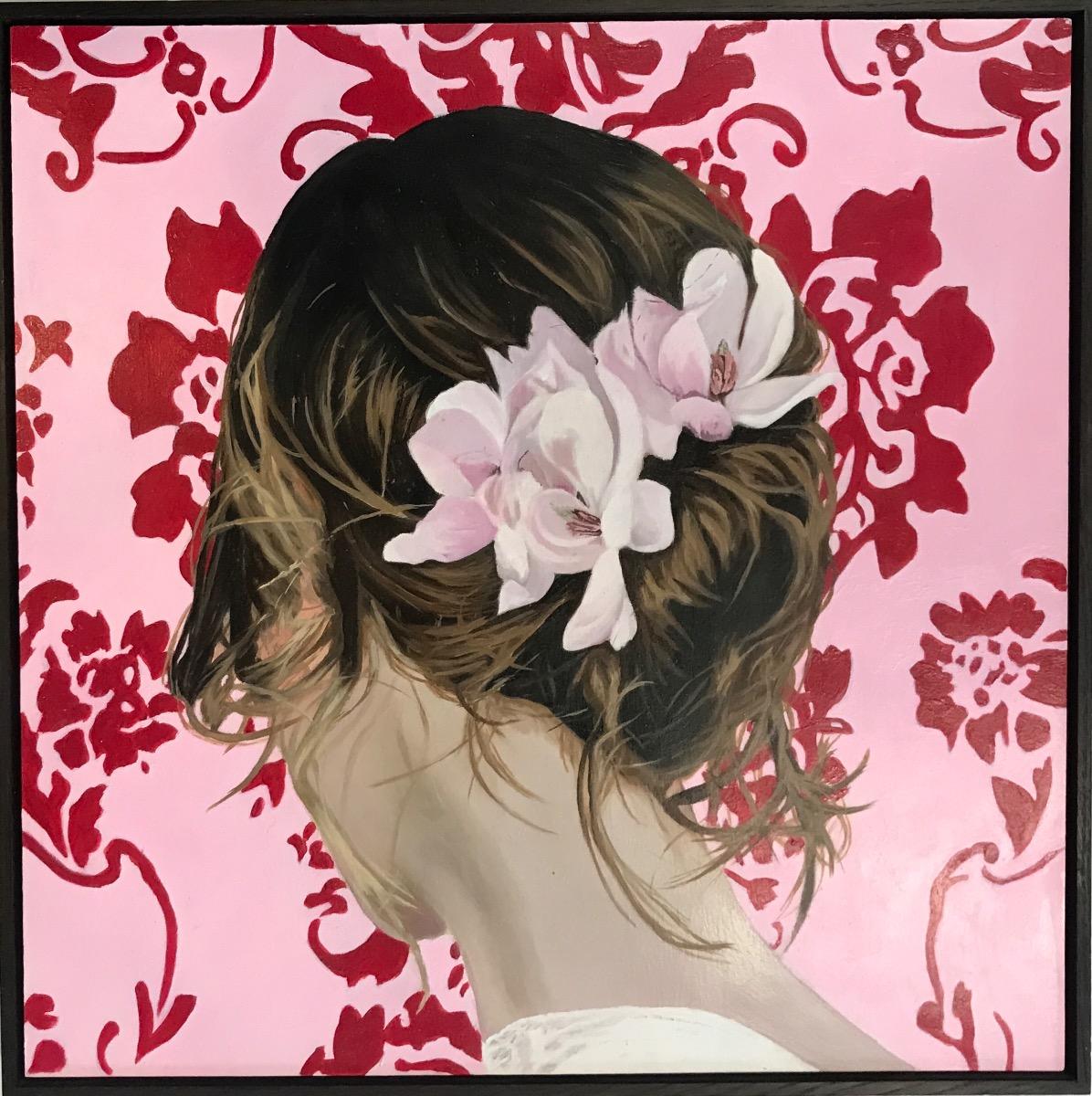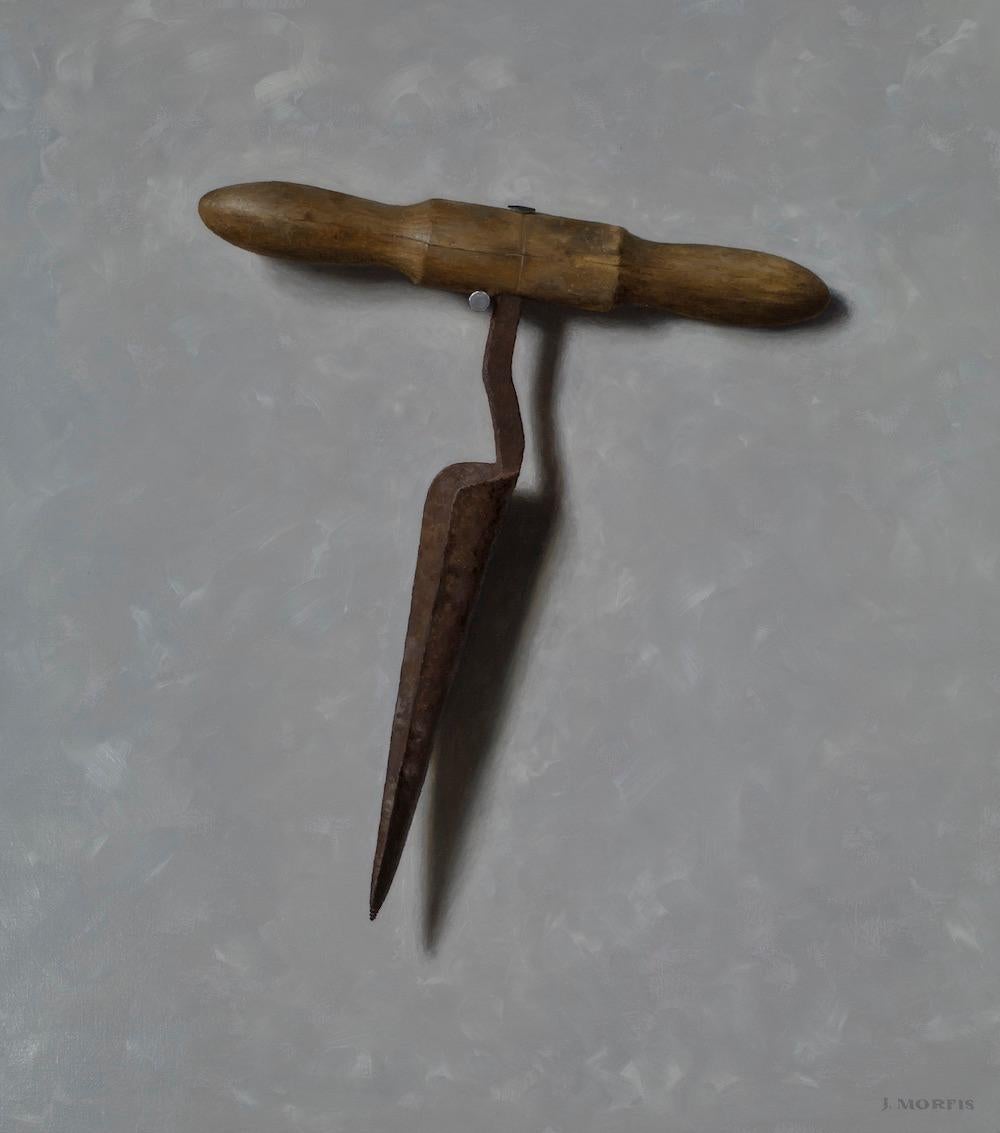Items Similar to Flower Still-life Virgin Trevisani Stanchi Paint Oil on canvas 17/18th Century
Want more images or videos?
Request additional images or videos from the seller
1 of 16
Flower Still-life Virgin Trevisani Stanchi Paint Oil on canvas 17/18th Century1680-1730
1680-1730
About the Item
Flower garland with a portrait of the Virgin
Francesco Trevisani (Capodistria 1656 - Rome 1746) and Niccolò Stanchi (Rome 1623 - 1690), attributable
Oil on canvas
66 x 49 cm. - In frame 76 X 60 cm.
The beautiful painting that we are pleased to present to you illustrates an opulent garland studded with a refined variety of flowers, set off by the contrast with the black background, distinguished by an elegant structure as well as the characteristic vivacity and brilliance of the colours. Inside is a portrait of the Virgin in prayer with her hands clasped to her breast.
This iconographic typology, namely the garland of flowers within which a sacred subject is inscribed, has Flemish origins, later spreading to Italy, to Rome in particular, where the first experiments in this sense can be traced back to Giovanni Stanchi and Mario Nuzzi, who were always indebted to Nordic culture, as can be seen from the ethereal naturalism that characterises their creations.
Entering into the details of our canvas, it is easy to deduce that it is the result of the successful collaboration of two painters who, as was customary for such creations, could devote themselves to their own specialisation, one to the religious image, the other to the garland of fresh flowers.
In particular, the half-bust of the Virgin is inspired by the Marian inventions of Francesco Trevisani (Capodistria 1656 - Rome 1746), fully reflecting his modus pingendi, with its typical expressive delicacy and marked taste for shaded, pearly colours. In particular, there are strong analogies with the work of the master, a fundamental reference point for many artists of the second half of the 17th century in Rome and an object of study and inspiration still relevant in the 18th century.
The elegant fluency of touch and sensual refinement typical of Trevisani, combined with a very accurate chiaroscuro rendering, inherited from his artistic training in Venice, and the exceptional sweetness of the drawing, the floridity of the complexion, and finally, the peculiar pose of the figure portrayed (the beauty of the two hands held to the chest is unmistakable), further support our attribution.
The garland can instead be attributed to the hand of the Roman painter Niccolò Stanchi (Rome 1623 - 1690), who distinguished himself among the best naturamortists active in Rome during the Baroque era.
The Stanchi family, Niccolò, Angelo and Giovanni, the workshop's founder, constituted one of the most fervent still life workshops in Baroque Rome from 1630 onwards, sought after by the most important families of the Roman aristocracy, from the Colonna to the Chigi to the Rospigliosi, and present in the Medici collections from the end of the century.
The painting is pervaded by a sumptuous elegance, given by the sinuous movement of the flowers, drawn with precision, and linked together in a sort of melody that unites them in a breath of Baroque taste, as well as by the ethereal figure of the Virgin in the centre of the canvas.
The counterpoint of the chromatic range accords the soft pinks of the peonies with the ethereal whites of the roses and orange blossoms, although what undoubtedly makes our canvas stand out and make it aristocratic is the preponderance of the intense blue of the anemones and hyacinths, which gives the composition a masterly touch of aristocratic elegance.
The work is completed by a beautiful gilded frame and is sold
accompanied by a certificate of photographic authenticity in accordance with the law.
ADDITIONAL INFORMATION:
We take care of and organise the transport of the purchased works, both for Italy and abroad, through professional and insured carriers.
Contact us for any information, we will be happy to answer you.
- Creation Year:1680-1730
- Dimensions:Height: 29.93 in (76 cm)Width: 23.63 in (60 cm)
- Medium:
- Movement & Style:
- Circle Of:Francesco Trevisani (Capodistria 1656 - Rome 1746) (1656 - 1746, Italian)
- Period:
- Condition:
- Gallery Location:Riva del Garda, IT
- Reference Number:1stDibs: LU988112372412
About the Seller
4.8
Platinum Seller
These expertly vetted sellers are 1stDibs' most experienced sellers and are rated highest by our customers.
Established in 2017
1stDibs seller since 2018
204 sales on 1stDibs
Typical response time: <1 hour
- ShippingRetrieving quote...Ships From: Riva del Garda, Italy
- Return PolicyA return for this item may be initiated within 7 days of delivery.
More From This SellerView All
- De Wit Flowers Still life Paint Oil on canvas 18th Century Flemish Cupids ArtLocated in Riva del Garda, ITJacob De Wit (Amsterdam, 1695 - 1754) attributable/ workshop Pair of Cupids with Garland of Flowers Oil on canvas 91 x 103 cm. - Framed 104 x 115 cm. Provenance: Christie's (London, Old master Painting 12.12.1996) lot 82 This magnificent composition depicts two cupids holding a garland of flowers, placed on a fine architecture with bas-reliefs and masks, presumably the top of a fountain. One of the two cupids sympathetically holds a part of it with his hands, while his head turns towards the viewer; the second cupid, on the other hand, must have clumsily broken the thread holding its end, and is sitting sullenly with a torch and a tear streaking his chubby cheek. The work, given its stylistic features and compositional taste, can be attributed to the Flemish artist Jacob de Wit (Amsterdam, 1695 - 1754), or to an artist from his workshop, with his typical triumphal and opulent style, which reveals clear influences from Rubens and Van Dijck, but also from Gerard de Lairesse...Category
18th Century Old Masters Paintings
MaterialsOil
- Flower Garland Virgin Paint Oil on canvas Old master 17th Century ItalyBy Giovanni StanchiLocated in Riva del Garda, ITGiovanni Stanchi (Rome 1608 - 1675) or Niccolò Stanchi (Rome 1623 - 1690), workshop of GARLAND OF FLOWERS WITH PORTRAIT OF THE VIRGIN Rome, First half of the Seventeenth century o...Category
17th Century Old Masters Paintings
MaterialsOil
- Still Lifes Flowers De Arellano Paint 17th Century Oil on canvas Old master ArtLocated in Riva del Garda, ITJosè de Arellano (Madrid, 1653 - c. 1714) attributable Pair of still lifes of flowers Oil on canvas 37 x 45 cm. - In period frames 50 x 59 cm. Pair of still lifes, each depicting a...Category
17th Century Old Masters Paintings
MaterialsOil
- Still-life Flower Paint Oil on canvas Old master 17th Century Lombard schoolLocated in Riva del Garda, ITFrancesca Volò Smiller, called Vincenzina (Milan, 1657 - 1700) - circle of Floral composition Oil on canvas (97 x 72 cm. - in octagonal frame 100 x 84 cm.) A rich floral compositio...Category
17th Century Old Masters Paintings
MaterialsOil
- Still Life Vanitas Noletti Paint Oil on canvas Old master 17th Century ItalianLocated in Riva del Garda, ITFrancesco Noletti known as the Maltese (Malta 1611-Rome 1654) Workshop/circle of Still life with musical instruments, toys, armour, textiles and precious objects Oil on canvas (52 x...Category
17th Century Old Masters Paintings
MaterialsOil
- Angels Flower Garzi Paint Oil on canvas Old master 17/18th Century Italian ArtBy Luigi Garzi (Pistoia 1638– Rome1721)Located in Riva del Garda, ITRoman school of the early 18th century Luigi Garzi (Pistoia 1638– Rome1721) attributed Still life of fruit supported by three angels Oil on oval canvas 116 x 91 cm., Framed 140 x 119 cm. Authentication on a photograph by Prof Giancarlo Sestieri, who attributes the work to the sphere of Luigi Garzi This magnificent canvas, depicting a sumptuous composition of fruit supported by three prosperous winged cherubs, from which comes a parchment bearing the Latin expression "Amor est vitae essentia", is to be placed in the production of a Roman author active between the second half of XVII century and the first of the following century. The iconography that sees represented cherubs with fruit or flowers is frequent in the Baroque period, especially in the Roman area, starting from the 1600s, with that particular depictional tendency aimed at illusionistic and frivolous images, to a type of paintings or frescoes of strong value decorative, intended for the private context and depicting jubilation of cherubs, angels or cherubs, and of which our canvas represents a perfect example. We can recall, among the most illustrious iconographic precedents, the elegant mirrors painted by Mario Nuzzi and Carlo Maratta that adorn the hall of Palazzo Colonna in Rome, and again the canvas preserved in the Rouen museum and the similar ones in Palazzo Chigi in Ariccia, with the collaboration for the figurative parts of Filippo Lauri. The commercial and furnishing success of similar works is also testified by authors such as Guglielmo Cortese known as Borgognone (1628 - 1679), Franz Werner Von Tamm (1658 - 1724), Giovan Battista Gaulli (1639 - 1709), Giovanni Paolo Castelli known as Spadino (Rome 1650 - 1740) and the aforementioned Carlo Maratta (1625 - 1713) The work, studied by Giancarlo Sestieri, was brought closer to the sphere of the eclectic Pistoian painter Luigi Garzi, one of the protagonists of Roman painting in the decades of transition between the seventeenth and eighteenth centuries. In our painting we can find the typical elements of his painting: the soft and delicately chiaroscuro light, the sculptural classicism of the figures as well as the stupendous luministic and chromatic effects. Luigi Garzi's training and artistic activity took place in the Eternal City and he was in effect a Roman artist. He moved to Rome from Pistoia, his hometown at a very young age, and joined the atelier of Andrea Sacchi, who directed his studies towards classicism, comparing himself with the works of Raphael, Domenichino and Nicolas Poussin, but also with the Emilian one. , with particular attention to the school of Guido Reni. But the Emilian examples were undoubtedly preceded, particularly by Giovani Lanfranco, who modeled his taste and style, together with a modulated cortonism, while those pre-eighteenth-century sensibilities are due to the lesson of Carlo Maratta. However, there is no doubt that the painter oriented his personality without ever bowing to imitation, reaching a refined elegance and autonomy of language, as the canvas in question clearly demonstrates in which the different influences find a refined amalgamation in perfect harmony with the baroque evolution between the seventeenth and eighteenth centuries, indicating a dating to its earliest maturity. These attitudes led the painter to obtain awards and prestigious commissions as soon as possible, such as the frescoes of Palazzo Borghese...Category
Late 17th Century Old Masters Paintings
MaterialsOil
You May Also Like
- Grand-Scale Old Master Garland Portrait, 17th Century, Signed & Dated, Rare workLocated in London, GBIndistinctly signed and dated In the first quarter of the 17th century a new form of flower painting was developed in Flemish painting, which, recreated by a large group of artists and workshops, would achieve considerable success throughout the century in much of Europe: the garland of flowers surrounding a central figure. Brueghel de Velurs was the initiator of this type of composition, however, it was his pupil, Daniel Seghers, who was the dominant figure in this specialised production and the creator of a prototype that would serve as a model for the numerous artists who followed in his wake. It seems undeniable that the artist of the present painting had seen the Garlands of Flowers Surrounding a Medallion Depicting the Triumph of Love by Daniel Seghers and Domenico Zampieri (now in the Musée du Louvre in Paris). In our painting, the present floral wreath encircles a carved cartouche within which sits Saint Dorothy of Caesarea and the attribute which often accompanies her in art, a basket of roses. The extremely delicate flowers have been rendered in meticulous detail, so that every species can be identified from exotic tulips to roses, irises and forget-me-nots; this obvious attention to naturalism is inherited from the Flemish manner. Each flower is so precise and refined that they are an individual study in their own right. The still-lifes are from the hand of Jan Anton van den Baren, with the central figures by another accomplished hand. Van den Baren’s arrangement of flowers would have delighted connoisseurs in both Flanders and in Vienna, where the impossibility of their all blooming at the same time of year would have been understood as a further statement of the wonder and beauty of the divine. Van den Baren worked first in Brussels, where he collaborated with Erasmus Quellinus II for the figures in his works, before moving with Archduke Leopold Wilhelm, his patron, to Vienna in 1656, where he instead worked with fellow Flemish émigré painter Nikolaus van Hoy. The iconography relates to an eighth century legend where she was presented a basket of roses by a child. In addition to the brilliance of his handling of still-lifes Van den Baren played an important art historical role as Director of Archduke Leopold Wilhelm’s Picture Gallery in Vienna, then one of the greatest collections in the world and the core of what was to become the present collection of the Kunsthistorisches Museum, Vienna. Van der Baren compiled an inventory of the collection in 1659, and his predecessor as Director of the Archduke’s Picture Gallery (when it was still housed in Flanders), David Teniers, depicted van der Baren (third from right) in his celebrated Archduke Leopold Willem in his gallery at Brussels, conserved at the Kunsthistorisches Museum. It is a shining example of the Flemish Baroque and is a very rare object indeed, considering there are only 14 paintings accepted as authentic works by this artist. We are grateful to Fred Meijer for confirming the attribution to Johannes Antonius van der Baren. A feature of this painting is its outstanding carved and gilded frame with a plethora of flowers and foliage. Titan Fine ArtCategory
17th Century Old Masters Portrait Paintings
MaterialsCanvas, Oil
- Young Girl after Sir Thomas Lawrence, Regency portrait paintingLocated in Brecon, PowysCharming work in the Regency style, mid 19th Century after Sir Thomas Lawrence. High quality painting. Old Christie's Stencil to verso. Would grace any home, suitable for contempor...Category
Mid-19th Century Old Masters Portrait Paintings
MaterialsCanvas, Oil
- Secret Moon Garden (The Shepherdess), Girl, Bird, PortraitLocated in Deddington, GBOriginal painting by Angela Smith showing girl enchanted by humming bird. A portrayal of young girl with brown hair tied back by white flowers looking up...Category
2010s Contemporary Portrait Paintings
MaterialsOil
- Tuesday's Girl (Sakura), Original Painting, Girl, Portrait, Floral, Woman, PinkLocated in Deddington, GBOriginal painting by Angela Smith showing back of girl's head. A portrayal of young girl with brown hair tied back by pink flowers. Surrounded by a vibr...Category
2010s Contemporary Portrait Paintings
MaterialsOil, Wood Panel
- Single Hummingbird, Original Painting, Bird, Animal, NatureLocated in Deddington, GBSingle hummingbird, oil on panel by Angela Smith Hummingbird on a green background, perfectly painted with lots of detail. ADDITIONAL INFORMATION: Singl...Category
2010s Contemporary Portrait Paintings
MaterialsOil, Wood Panel
- Garden DibbleBy John MorfisLocated in Sag Harbor, NYAn oil painting of an antique tool, a Garden Dibble, which is a long stick-like tool used to make holes for seeds, to make sure they are sufficiently buried in the soil without damage. This particular object that Morfis chose to paint has a wooden handle, and a metal point. The dibber rests atop a nail, against a gray wall. Bright studio-light casts a sharp shadow directly beneath the tool. Painted in the academic realist style of "trompe-l'oeil" which is French for "trickery of the eye". BIOGRAPHY John Morfis was born in Glen Cove, Long Island in 1976. His humble beginnings made pursuing a career in art difficult and paradoxically necessary. Fixated on making things aesthetically pleasing, John made an extreme departure from his family life when he chose to base his life on art. Surrounded by mechanics, welders, and otherwise trade workers John had a tough time expressing his interest in a world much more utilitarian and much less expressive and impractical. With an extraordinary desire to be an artist and a grant awarded, John was able to earn a Bachelor of Fine Arts with a concentration in painting from the University of Hartford in 1998. While there John studied oil painting under American realist Stephen Brown. John’s first solo show took place in 2007 at the Ellen Traut Collection Gallery in Hartford, CT and was a near sell out. Since then John has had success up and down the northeastern coast of the United States working with various galleries and collectors. His work has also appeared in various group shows at the New Britain Museum of American Art in Connecticut. ARTIST STATEMENT Each painting, although a portrait of a tired hand...Category
21st Century and Contemporary American Realist Still-life Paintings
MaterialsLinen, Oil
Recently Viewed
View AllMore Ways To Browse
Antique Italian Still Life
Garland Flower
Virgin Painting
Flemish Flowers
Old Masters Venice
Antique Italian Still Life Painting
18th Century Flower Paintings
Flemish Flower Painting
Virgin Oil Painting
Old Master Paintings Venice
Old Masters Paintings Of Venice
Old Master Still Life Of Flowers
Garland Collection
Italian Old Master Still Life Paintings
Peony Still Life
Antique Rose On Canvas
Orange Blossom Flower
Old Masters Oil Still Life Flowers





